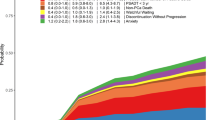Abstract
Purpose
In patients considered for active surveillance (AS), the use of MRI and targeted biopsies (TB) at entry challenges the approach of routine “per protocol” repeat systematic biopsies (SB) at 1 year. This pilot study aimed to assess whether an approach of performing repeat biopsies only if PSA kinetics are abnormal would be safe and sufficient to detect progression.
Methods
Prospective single-centre study of 149 patients on AS with low-risk PCa, a negative MRI at entry, followed for a minimum of 12 months between 01/2007 and 12/2015. Group 1 (n = 78) patients had per-protocol 12-month repeat SB; group 2 (n = 71) patients did not. Surveillance tests for tumour progression were for both groups: for cause SB and MRI-TB biopsies if PSA velocity (PSA-V) > 0.75 ng/ml/year, or PSA doubling time (PSADT) < 3 years. The main objectives are to compare the 2-year rates of tumour progression and AS discontinuation between groups. The secondary objectives are to estimate the diagnostic power of PSA-V and PSA-DT, to predict the risk of tumour progression.
Results
Overall, 21 out of 149 patients (14.1%) showed tumour progression, 17.1% for group 1 and 12.3% for group 2, and 31 (21.2%) discontinued AS at 2 years. There was no difference between the 2 groups (p = 0.56). The area under the PSA-V and PSADT curves to predict tumour progression was 0.92 and 0.83, respectively.
Conclusions
We did not find any significant difference for progression and AS discontinuation rate between the 2 groups. The PSA kinetic seems accurate as a marker of tumour progression. These results support the conduct of a multi-centre prospective trial to confirm these findings.


Similar content being viewed by others
References
Bul M, Zhu X, Valdagni R, Pickles T, Kakehi Y, Rannikko A et al (2013) Active surveillance for low-risk prostate cancer worldwide: the PRIAS study. Eur Urol 63(4):597–603
Klotz L (2010) Active surveillance for prostate cancer: patient selection and management. Curr Oncol Tor Ont 17(Suppl 2):S11–S17
Bruinsma SM, Bangma CH, Carroll PR, Leapman MS, Rannikko A, Petrides N et al (2016) Active surveillance for prostate cancer: a narrative review of clinical guidelines. Nat Rev Urol 13(3):151–167
Ouzzane A, Renard-Penna R, Marliere F, Mozer P, Olivier J, Barkatz J et al (2015) Magnetic resonance imaging targeted biopsy improves selection of patients considered for active surveillance for clinically low risk prostate cancer based on systematic biopsies. J Urol 194(2):350–356
Thurtle D, Barrett T, Thankappan-Nair V, Koo B, Warren A, Kastner C et al (2018) Progression and treatment rates using an active surveillance protocol incorporating image-guided baseline biopsies and multiparametric magnetic resonance imaging monitoring for men with favourable-risk prostate cancer. BJU Int. https://doi.org/10.1111/bju.14166
Thoma C (2015) Prostate cancer: avoiding excess confirmatory biopsies. Nat Rev Urol 12(9):476
Bruinsma SM, Roobol MJ, Carroll PR, Klotz L, Pickles T, Moore CM et al (2017) Expert consensus document: semantics in active surveillance for men with localized prostate cancer—results of a modified Delphi consensus procedure. Nat Rev Urol. https://doi.org/10.1038/nrurol.2017.26
McLaren DB, McKenzie M, Duncan G, Pickles T (1998) Watchful waiting or watchful progression? Prostate specific antigen doubling times and clinical behavior in patients with early untreated prostate carcinoma. Cancer 82(2):342–348
van den Bergh RCN, Roemeling S, Roobol MJ, Aus G, Hugosson J, Rannikko AS et al (2009) Outcomes of men with screen-detected prostate cancer eligible for active surveillance who were managed expectantly. Eur Urol 55(1):1–8
Cooperberg MR, Brooks JD, Faino AV, Newcomb LF, Kearns JT, Carroll PR et al (2018) Refined Analysis of Prostate-specific Antigen Kinetics to Predict Prostate Cancer Active Surveillance Outcomes. Eur Urol. https://doi.org/10.1016/j.eururo.2018.01.017
Vargas HA, Akin O, Afaq A, Goldman D, Zheng J, Moskowitz CS et al (2012) Magnetic resonance imaging for predicting prostate biopsy findings in patients considered for active surveillance of clinically low risk prostate cancer. J Urol 188(5):1732–1738
Fütterer JJ, Briganti A, De Visschere P, Emberton M, Giannarini G, Kirkham A et al (2015) Can clinically significant prostate cancer be detected with multiparametric magnetic resonance imaging? A systematic review of the literature. Eur Urol 68(6):1045–1053
Bruinsma SM, Bokhorst LP, Roobol MJ, Bangma CH (2016) How often is biopsy necessary in patients with prostate cancer on active surveillance? J Urol 195(1):11–12
D’amico AV, Hanks GE (1993) Linear regressive analysis using prostate-specific antigen doubling time for predicting tumor biology and clinical outcome in prostate cancer. Cancer 72(9):2638–2643
Soloway MS, Soloway CT, Williams S, Ayyathurai R, Kava B, Manoharan M (2008) Active surveillance; a reasonable management alternative for patients with prostate cancer: the Miami experience. BJU Int 101(2):165–169
Khatami A, Ali K, Aus G, Gunnar A, Damber J-E, Jan-Erik D et al (2007) PSA doubling time predicts the outcome after active surveillance in screening-detected prostate cancer: results from the European randomized study of screening for prostate cancer, Sweden section. Int J Cancer 120(1):170–174
Venkitaraman R, Norman A, Woode-Amissah R, Fisher C, Dearnaley D, Horwich A et al (2007) Predictors of histological disease progression in untreated, localized prostate cancer. J Urol 178(3 Pt 1):833–837
Iremashvili V, Manoharan M, Lokeshwar SD, Rosenberg DL, Pan D, Soloway MS (2013) Comprehensive analysis of post-diagnostic prostate-specific antigen kinetics as predictor of a prostate cancer progression in active surveillance patients. BJU Int 111(3):396–403
Iremashvili V, Kava BR, Manoharan M, Parekh DJ, Punnen S (2016) Is it time to revisit the role of prostate-specific antigen kinetics in active surveillance for prostate cancer? Urology 95:139–144
Patel HD, Feng Z, Landis P, Trock BJ, Epstein JI, Carter HB (2014) Prostate specific antigen velocity risk count predicts biopsy reclassification for men with very low risk prostate cancer. J Urol 191(3):629–637
Author information
Authors and Affiliations
Corresponding author
Rights and permissions
About this article
Cite this article
Olivier, J., Kasivisvanathan, V., Drumez, E. et al. Low-risk prostate cancer selected for active surveillance with negative MRI at entry: can repeat biopsies at 1 year be avoided? A pilot study. World J Urol 37, 253–259 (2019). https://doi.org/10.1007/s00345-018-2420-6
Received:
Accepted:
Published:
Issue Date:
DOI: https://doi.org/10.1007/s00345-018-2420-6




